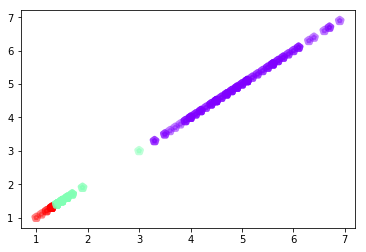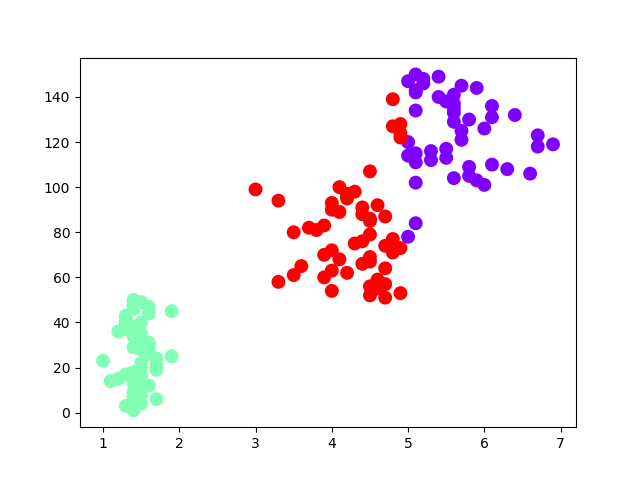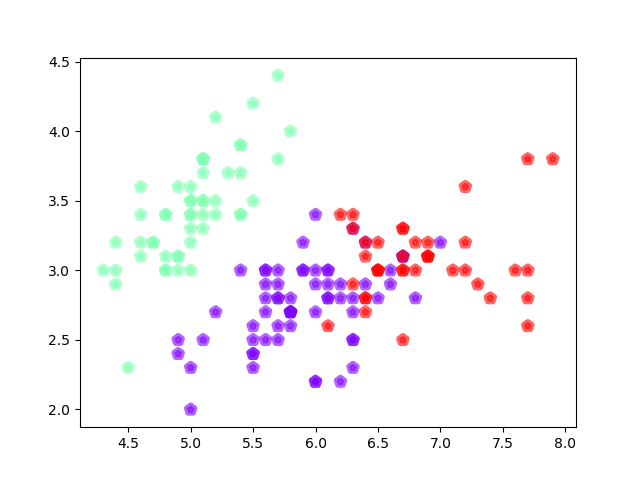第八次作业
聚类--K均值算法:自主实现与sklearn.cluster.KMeans调用
用python实现K均值算法,鸢尾花花瓣长度数据做聚类并用散点图显示。
代码:
import numpy as np #随机生成一个数组 x = np.random.randint(1,100,[20,1]) y = np.zeros(x.shape[0],dtype=int) k = 3 iris_length = [1.4, 1.4, 1.3, 1.5, 1.4, 1.7, 1.4, 1.5, 1.4, 1.5, 1.5, 1.6, 1.4, 1.1, 1.2, 1.5, 1.3, 1.4, 1.7, 1.5, 1.7, 1.5, 1.0, 1.7, 1.9, 1.6, 1.6, 1.5, 1.4, 1.6, 1.6, 1.5, 1.5, 1.4, 1.5, 1.2, 1.3, 1.4, 1.3, 1.5, 1.3, 1.3, 1.3, 1.6, 1.9, 1.4, 1.6, 1.4, 1.5, 1.4, 4.7, 4.5, 4.9, 4.0, 4.6, 4.5, 4.7, 3.3, 4.6, 3.9, 3.5, 4.2, 4.0, 4.7, 3.6, 4.4, 4.5, 4.1, 4.5, 3.9, 4.8, 4.0, 4.9, 4.7, 4.3, 4.4, 4.8, 5.0, 4.5, 3.5, 3.8, 3.7, 3.9, 5.1, 4.5, 4.5, 4.7, 4.4, 4.1, 4.0, 4.4, 4.6, 4.0, 3.3, 4.2, 4.2, 4.2, 4.3, 3.0, 4.1, 6.0, 5.1, 5.9, 5.6, 5.8, 6.6, 4.5, 6.3, 5.8, 6.1, 5.1, 5.3, 5.5, 5.0, 5.1, 5.3, 5.5, 6.7, 6.9, 5.0, 5.7, 4.9, 6.7, 4.9, 5.7, 6.0, 4.8, 4.9, 5.6, 5.8, 6.1, 6.4, 5.6, 5.1, 5.6, 6.1, 5.6, 5.5, 4.8, 5.4, 5.6, 5.1, 5.1, 5.9, 5.7, 5.2, 5.0, 5.2, 5.4, 5.1] # 选取前k个值作为中心值 def intcenter(myarr,k): return x[:k] kc = intcenter(x,k) # 计算距离 def nearest(kc, i): d = abs(kc - i) w = np.where(d == np.min(d)) return w[0][0] # 计算样本中每个数据应该为哪个类 def xclassify(x,y,kc): for i in range(x.shape[0]): y[i] = nearest(kc, x[i]) return y # 更新聚类中心 def kcmean(x,y,kc,k): l = list(kc) flag = False for i in range(k): part = np.where(y == i)[0] if len(np.where(y == i)[0]) == 0: newcenter = l[i] else: newcenter = np.mean(x[part]) if newcenter != l[i]: # 如果原中心和新中心不相等,就再赋值,并标记 l[i] = newcenter flag = True # 标记 return np.array(l),flag # 整合 def k_means(x,k): y = np.zeros(x.shape[0]) # 选取k个中心 kc = intcenter(x,k) # 每个元素进行分类,重新计算新中心,并判断中心是否发生变化 flag = True while flag: y = xclassify(x,y,kc) result,flag = kcmean(x,y,kc,k) return result # 不断迭代分类 flag = True while flag: y = xclassify(x,y,kc) kc,flag = kcmean(x,y,kc,k) print(kc,flag) # 用鸢尾花花瓣作分析 x = np.array(iris_length) y = np.zeros(x.shape[0]) kc = intcenter(x,3) flag = True while flag: y = xclassify(x,y,kc) kc,flag = kcmean(x,y,kc,3) print(kc,flag) # 分析鸢尾花花瓣长度的数据,并用散点图表示出来 import matplotlib.pyplot as plt plt.scatter(iris_length, iris_length, marker='p', c=y, alpha=0.5, linewidths=4, cmap='rainbow') plt.show()
截图:

用sklearn.cluster.KMeans,鸢尾花花瓣长度数据做聚类并用散点图显示,鸢尾花完整数据做聚类并用散点图显示。
代码:
import numpy as np from sklearn.cluster import KMeans from sklearn.datasets import load_iris from matplotlib import pyplot iris_data = load_iris() # 花瓣长度做聚类 iris_length = iris_data.data[:, 2:3] x1 = iris_length k_means1 = KMeans(n_clusters=3) result1 = k_means1.fit(x1) kc1 = result1.cluster_centers_ y_kmeans1 = k_means1.predict(x1) # 画图 pyplot.scatter(x1,np.linspace(1,150,150),c=y_kmeans1,marker='x',cmap='rainbow',linewidths=4) pyplot.show() # 完整数据的聚类 x2 = iris_data.data k_means2 = KMeans(n_clusters=3) result2 = k_means2.fit(x2) kc2 = result2.cluster_centers_ y_kmeans2 = k_means2.predict(x2) print(y_kmeans2, kc2) print(kc2.shape, y_kmeans2.shape, x2.shape) pyplot.scatter(x2[:, 0], x2[:, 1], c=y_kmeans2, marker='p', cmap='rainbow', linewidths=4, alpha=0.6) pyplot.show()
截图:
花瓣长度聚类散点

完整数据聚类散点图:





 浙公网安备 33010602011771号
浙公网安备 33010602011771号